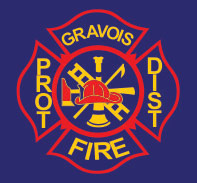OPEN BURNING
Open Burning Regulations
Open burning in Missouri is regulated by the Missouri Department of Natural Resources and each fire district, county or city may adopt their own regulations in addition to the state regulations.
The following cannot be burned in Missouri:
Waste generated by a business, trade, industry, salvage or demolition operation, other materials including but not limited to: tires, rubber products, hazardous materials, Styrofoam, plastics, petroleum based products, demolition waste, treated wood, old appliances, carpet, furniture and any asbestos containing material.
A home owner residing in a dwelling of four units or less but not in mobile home parks or apartment complexes; may burn solid waste produced by routine household activities as long as the waste is produced on site and not otherwise restricted and may burn lawn and yard waste, including trees, leaves, brush and other vegetation, as long as it originates from the location it is burned.
Trees and brush from a land clearing operation may be burnt with proper permitting.
Other state statutes apply to liability from open burning; if a fire you set or allow to burn causes damage to another’s property or causes injury to another you are liable for that damage or injury and could be subject to civil and criminal prosecution.
Local Regulations
The Gravois Fire Protection District requires all persons conducting open burning within the boundaries of the Fire District to make notification prior to conducting any burning. Notification is not required for incinerators and camp fires. Notification does not relieve the parties conducting the burn from complying with any other regulations currently in effect.
To make notification, call the Morgan County Communications Center at 573-378-5481, wait for the menu to start and stay on the line or press 2, an operator will answer: tell them you are going to conduct an open burn, they will ask for your name, address and a phone number where they can call you back.
If open burning advisories have been issued or a ban on burning is in effect the Communications Center Operator will have that information.
US Forestry service matrix and descriptions:
- Low (L) (Green) – Fuels do not ignite readily from small firebrands although a more intense heat source, such as lightning, may start fires in duff or punky wood. Fires in open cured grasslands may burn freely a few hours after rain, but woods fires spread slowly by creeping or smoldering and burn in irregular fingers. There is little danger of spotting.
- Moderate (M) (Blue) – Fires can start from most accidental causes but, with the exception of lightning fires in some areas, the number of starts is generally low. Fires in open cured grasslands will burn briskly and spread rapidly on windy days. Timber fires spread slowly to moderately fast. The average fire is of moderate intensity, although heavy concentrations of fuel, especially draped fuel, may burn hot. Short-distance spotting may occur but is not persistent. Fires are not likely to become serious and control is relatively easy.
- High (H) (Yellow) – All fine dead fuels ignite readily and fires start easily from most causes. Unattended brush and campfires are likely to escape. Fires spread rapidly and short-distance spotting is common. High-intensity burning may develop on slopes or in concentrations of fine fuels. Fires may become serious and their control difficult unless they are attacked successfully while small.
- Very High (VH) (Orange) – Fires start easily from all causes and, immediately after ignition, spread rapidly and increase quickly in intensity. Spot fires are a constant danger. Fires burning in light fuels may quickly develop high-intensity characteristics such as long-distance spotting and fire whirlwinds when they burn into heavier fuels.
- Extreme (E) (Red) – Fires start quickly, spread furiously, and burn intensely. All fires are potentially serious. Development into high-intensity burning will usually be faster and occur from smaller fires than in the very high fire danger class. Direct attack is rarely possible and may be dangerous except immediately after ignition. Fires that develop headway in heavy slash or in conifer stands may be unmanageable while the extreme burning condition lasts. Under these conditions, the only effective and safe control action is on the flanks until the weather changes or the fuel supply lessens.
